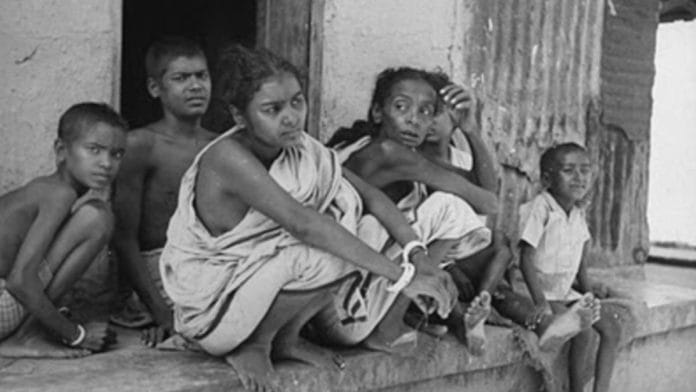New Delhi: How do 30 lakh deaths out of a population of 6 crore become mere statistics in history books? One of the most horrific disasters of 20th century South Asia, the Bengal Famine has suffered collective amnesia and lack of accountability for 81 years.
This was precisely the subject of ‘The Story of the Bengal Famine of 1943’, a panel discussion between journalist Kavita Puri, writer Sailen Sarkar, and history professor Srimanjari, moderated by BBC journalist Yogita Limaye. Held at New Delhi’s CD Deshmukh Auditorium at India International Centre, the discussion is set to be released as an episode of Puri’s podcast series, Three Million, on BBC Sounds.
I had never seen a name of one of the 3 million people,” said Puri, who grew up in Britain and had never come across even the briefest mentions of the famine in school textbooks.
A loss of 30 lakh lives under the British crown and not a single plaque in the world to commemorate them—this ignorance drove Puri to find out the people behind this number.
To understand why remembrance of it today is so complicated,” she explained.
Focus on accountability
Srimanjari, who teaches at Miranda House and has authored the book, Through War and Famine, called the 1943 disaster an “absolutely man-made famine.” After holding the British responsible for the famine, she turned to the Second World War for additional context.
With Japanese aggression becoming exponentially stronger in Southeast Asia and the war becoming inevitable by the day, the Imperial government soon realised that Bengal was in the line of attack. “It was then that the military authorities of colonial India started taking up a series of panic measures,” she added.
One such measure was the “denial policy” in which huge supplies of rice and thousands of boats in Bengal were confiscated to deny resources to the Japanese Army in case of a future invasion. This, in the backdrop of war-related inflation and stockpiling of rice by industrialists and government agencies, led to masses in Bengal panicking as rice started disappearing from the market.
“This famine took a toll of more than 3.5 million lives,” said Srimanjuri, pointing out that the famine continued up until 1945-6, resulting in large-scale epidemics in rural Bengal.
The other thorny question gnawing at British conscience is that of Winston Churchill, then-Prime Minister, whose derogatory views on Indians are said to have considerably affected his response to the famine.
In an episode of Three Million—which was the finalist for the Orwell Prize for Journalism 2024—Puri spoke with Max Hastings, a well-known biographer of Churchill. An audio snippet of this was played at the auditorium, where Hastings said, “All realistic historians and biographers of Churchill must recognise this very large blot on his record.”
According to Hastings, Churchill could’ve done a lot more at the time to send food imports to India.
Also read: Proved by science: Winston Churchill, not nature, caused 1943 Bengal famine
Dignity in a name
Accountability often features in discussions on the famine. “I felt that it [accountability] obscured other questions, like the question of 3 million,” said Puri, who seeks to shift the lens from accountability to the forgotten stories of the victims and survivors of the famine.
Tackling the question of public amnesia, Puri said that the 1940s was an incredibly tumultuous decade in India. Gandhi’s Quit India Movement, the Bengal Famine, the Calcutta Killings, and finally, the upheaval of Partition—things were unfolding rapidly in Bengal.
“And somehow in the events of the ’40s, the Bengal Famine has not been as well remembered,” Puri said.
For Puri, one of the most compelling discoveries of her research came from a pamphlet, ‘Hungry Bengal’ by artist and writer Chittaprosad Bhattacharya. During the famine, he travelled to Midnapore in West Bengal and drew sketches of victims of the famine, sometimes even dead people. Around 5,000 copies of ‘Hungry Bengal’ were confiscated by the British in 1943—all except one. Puri found the name of a victim in that one preserved copy.
“There’s dignity in a name,” she said, having uncovered a name amongst lakhs unnamed and forgotten.
Also read: When ‘Times of India’ advised the govt to slap sedition charges against Tilak
Role of artists in remembrance
Panellist Sarkar, editor of Gangchil Patrika, works as a ‘memory collector’, contributing to the remembrance of the 1943 Bengal Famine. He has been travelling around Bengal’s countryside with a pen and a notebook for years, gathering first-hand accounts from survivors of the famine.
“I am not a research scholar, I just want to hear the stories of people,” said Sarkar, whose childhood memories are coloured by images of the famine.
His father left East Bengal to work at Gandhi’s Khadi Pratishthan in Calcutta. When the famine broke out, he took photographs of the starving people lying on the streets, and later made it into an album. The faces in this album would haunt Sarkar while growing up.
“After many years, when I would talk to some old people, I could match their faces with the faces in the album,” he said.
A lot of what has seeped into the popular discourse surrounding the famine revolves around two words: ‘Fyan dao (Give us rice water)’. “What people [were] asking for is the starch water of rice, not even rice itself,” said Puri.
These harrowing cries for just the remnants of food have also been documented in Satyajit Ray’s Golden Lion-winning Ashani Sanket. Several poets like Birendra Chattopadhyay penned what would become the cultural remembrance of a famine-struck Bengal in their poetry.
The audience, filled with greying historians, academicians, journalists and even Army officers, was rife with their own tales of the famine. Pointing out how the 1943 disaster affected Bengal’s countryside much more than the urban regions, Vinod Sharma from the audience questioned the use of “famine” to describe it.
“I take serious objection to the use of the word ‘famine’. It was genocide, it wasn’t a famine,” he said.
(Edited by Prasanna Bachchhav)






